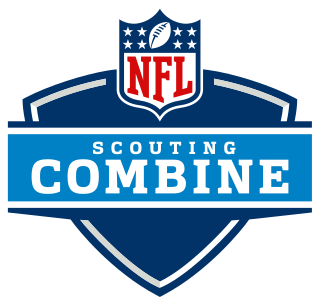
Vincent Edward "Bo" Jackson is an American former professional baseball and football player. He is the only professional athlete in history to be named an All-Star in two major North American sports. Jackson's achievements at the elite levels of multiple sports have given him a reputation as one of the greatest athletes.
The multi-stage fitness test (MSFT), also known as the beep test, bleep test, PACERtest (progressive aerobic cardiovascular endurance run), or the 20m shuttle run test, is a running test used to estimate an athlete's aerobic capacity (VO2 max).

Bryan Ezra Tsumoru Clay is an American decathlete who was the 2008 Summer Olympic champion for the decathlon and was also World champion in 2005.
Rodolfo ("Rudy") Chapa is a retired American track and field athlete who specialized in the middle to long-distance events. He set the US high school national record for the 10,000 meters when he ran 28:32 in 1976. Chapa was one of the most versatile distance runners, with a remarkable competitive range from the 1500 meters to the marathon. He is the son of Mexican immigrants. His father Rodolfo Sr. moved to the US as a mechanic through the Bracero program.

The NFL Scouting Combine is a week-long showcase occurring every February at Lucas Oil Stadium in Indianapolis, where college football players perform physical and mental tests in front of National Football League coaches, general managers, and scouts. With increasing interest in the NFL Draft, the scouting combine has grown in scope and significance, allowing personnel directors to evaluate upcoming prospects in a standardized setting. Its origins stem from the National, BLESTO, and Quadra Scouting organizations in 1977.

A vertical jump or vertical leap is the act of jumping upwards into the air. It can be an exercise for building both endurance and strength, and is also a standard test for measuring athletic performance. It may also be referred to as a Sargent jump, named for Dudley Allen Sargent.

The 2006 Florida Gators football team represented the University of Florida in the sport of American football during the 2006 college football season. The Gators competed in the Football Bowl Subdivision (FBS) of the National Collegiate Athletic Association (NCAA) and the Eastern Division of the Southeastern Conference (SEC), and played their home games at Ben Hill Griffin Stadium on the university's Gainesville, Florida campus. The season was the second for head coach Urban Meyer, who led the Gators to an SEC Championship, a BCS National Championship, and an overall win–loss record of 13–1 (.929). Their one loss coming from an upset by the Auburn Tigers.

The 2007 Florida Gators football team represented the University of Florida in the sport of American football during the 2007 NCAA Division I FBS football season. The Gators competed in the Football Bowl Subdivision (FBS) of the National Collegiate Athletic Association (NCAA) and the Eastern Division of the Southeastern Conference (SEC), and played their home games at Ben Hill Griffin Stadium on the university's Gainesville, Florida campus. It was the third season for head coach Urban Meyer, who led the Gators to a Capital One Bowl berth and an overall win–loss record of 9–4 (.692).

The 2009 FedEx BCS National Championship Game was an American football game played at Dolphin Stadium in Miami Gardens, Florida, on January 8, 2009. It was the national championship game for the 2008 NCAA Division I FBS football season, and featured the second-ranked Florida Gators against the top-ranked Oklahoma Sooners. The two participants were determined by the BCS Rankings to decide the BCS National Championship. Television coverage in the United States was provided by Fox, and radio coverage by ESPN Radio. The game was the last BCS Championship to air on Fox; starting with the 2010 game, ABC or ESPN televised the championship.

The 2008 Florida Gators football team represented the University of Florida in the sport of American football during the 2008 NCAA Division I FBS football season. The Gators competed in the Football Bowl Subdivision (FBS) of the National Collegiate Athletic Association (NCAA) and the Eastern Division of the Southeastern Conference (SEC), and played their home games in Ben Hill Griffin Stadium on the university's Gainesville, Florida, campus. They were led by fourth-year head coach Urban Meyer.

Ryan Reynolds is a former linebacker for the Oklahoma Sooners. He was a four-year standout in football and judo in high school, both at Lake Havasu High School in Arizona and at Bishop Gorman High School in Summerlin, Nevada, where he was recognized nationally.
The three-cone drill, 3-cone drill or L-drill is a test performed by American football players. It is primarily run to evaluate the agility, quickness and fluidity of movement of players by scouts. It is most commonly seen at the NFL Combine in preparation for the NFL draft but is also an important measurement for collegiate recruiting. While not as highly regarded a test as the 40-yard dash, it is still an important measure used by team personnel to compare players. It is especially pertinent in the evaluation of pass rushers who must be able to maintain acceleration while working around offensive line players. The drill was invented by football scout C. O. Brocato.

Timothy Richard Tebow is an American former football quarterback who played in the National Football League (NFL) for three seasons, primarily with the Denver Broncos. Tebow played college football for the Florida Gators, where he became the first underclassman to win the Heisman Trophy and led the team to two BCS National Championship titles in 2007 and 2009. At the conclusion of his collegiate career, he held the Southeastern Conference's records for career passing efficiency and rushing touchdowns. He was selected by the Broncos in the first round of the 2010 NFL Draft.

The UPMC Rooney Sports Complex is a multipurpose, multisport training, sports science, and sports medical complex of the University of Pittsburgh Medical Center. The complex is located along the shore of the Monongahela River in Pittsburgh, Pennsylvania, and is unique in that it is the only facility in the United States housing the practice and training facilities for both a collegiate National Collegiate Athletic Association (NCAA) football team and a professional National Football League (NFL) team, the Pittsburgh Panthers and Pittsburgh Steelers respectively. It is also unique in that it combines these training facilities in one location with an academically based sports science and medicine program. The complex consists of four centers which include the Center for Sports Medicine, Sports Training Center, Indoor Training Center, and the Fitness and Conditioning Center located in three buildings along with four outdoor practice fields all situated on 40 acres (16 ha) of land. The UPMC Center for Sports Medicine located in the complex is an international destination for amateur and professional athletes alike for its training, medical, and rehabilitation studies and services.

Tiffany Kiara Hayes is an American-Azerbaijani former professional basketball player. Her last team was the Connecticut Sun of the Women's National Basketball Association (WNBA). Hayes played college basketball for the Connecticut Huskies, playing for the 2009 and 2010 NCAA National Champions.

The Oregon Ducks track and field program is the intercollegiate track and field team for the University of Oregon located in the U.S. state of Oregon. The team competes at the NCAA Division I level and is a member of the Pac-12 Conference. The team participates in indoor and outdoor track and field as well as cross country. Known as the Ducks, Oregon's first track and field team was fielded in 1895. The team holds its home meets at Hayward Field in Eugene, Oregon. Jerry Schumacher is the current head coach and since the program's inception in 1895, there have only been eight permanent head coaches. The Ducks claim 32 NCAA National Championships among the three disciplines.
Total quarterback rating is a proprietary statistic created by ESPN in 2011 to measure the performance of quarterbacks in American football. According to ESPN, "QBR incorporates all of a quarterback's contributions to winning, including how he impacts the game on passes, rushes, turnovers, and penalties. Since QBR is built from the play level, it accounts for a team's level of success or failure on every play to provide the proper context, then allocates credit to the quarterback and his teammates to produce a clearer measure of quarterback efficiency."

The AFL Draft Combine, formerly known as the AFL Draft Camp, is a gathering of prospective talent, where selected potential draftees display their athletic prowess and relevant Australian rules football skills. Over four days participants are required to undergo a series of medical, psychomotor, athletic and fitness tests as well as interviews conducted by the 18 clubs in the Australian Football League. The first AFL Draft Camp was held in 1994 at Waverley Park; in 1999 it moved to Canberra, where it was hosted by the Australian Institute of Sport, and in 2011 it was moved to Docklands Stadium. Each year the Draft Combine is held in the week following the AFL Grand Final.
The Yo-Yointermittent test is aimed at estimating performance in stop-and-go sports like football (soccer), cricket, basketball and the like. It was conceived around the early 1990s by Jens Bangsbo, a Danish soccer physiologist, then described in a 2008 paper, "The Yo-Yo Intermittent Recovery Test". Like many other tests of fitness, it involves running at ever-increasing speeds, to exhaustion. However, a crucial difference is that the Yo-Yo Intermittent test has periodic rest intervals, thus simulating the nature of exertion in stop-and-go sports.

The 3:16 game was a National Football League playoff game between the 2011 Denver Broncos and the 2011 Pittsburgh Steelers on January 8, 2012. The game took place in the 2011–12 NFL playoffs and finished with five statistics that each contained three digits in the order 3–1–6. It was the first playoff game to go to overtime since a 2010 overtime rule was codified stating both teams could possess the ball unless one scored a touchdown. The game also set a record for the shortest overtime in NFL history; it took 11 seconds and the Denver Broncos scored on their first play in overtime.












